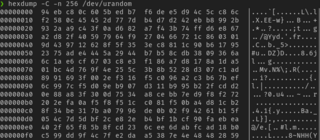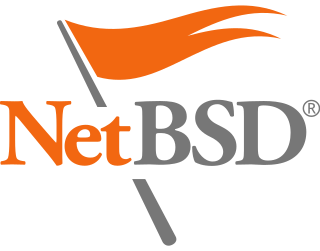Related Research Articles

In computer science, a thread of execution is the smallest sequence of programmed instructions that can be managed independently by a scheduler, which is typically a part of the operating system. In many cases, a thread is a component of a process.
In computer science, read-copy-update (RCU) is a synchronization mechanism that avoids the use of lock primitives while multiple threads concurrently read and update elements that are linked through pointers and that belong to shared data structures.

DragonFly BSD is a free and open-source Unix-like operating system forked from FreeBSD 4.8. Matthew Dillon, an Amiga developer in the late 1980s and early 1990s and FreeBSD developer between 1994 and 2003, began working on DragonFly BSD in June 2003 and announced it on the FreeBSD mailing lists on 16 July 2003.
Light Weight Kernel Threads (LWKT) is a computer science term and from DragonFly BSD in particular. LWKTs differ from normal kernel threads in that they can preempt normal kernel threads. According to Matt Dillon, DragonFlyBSD creator:
The LWKT scheduler is responsible for actually running a thread. It uses a fixed priority scheme, but the fixed priorities are differentiating major subsystems, not user processes. For example, hardware interrupt threads have the highest priority, followed by software interrupts, kernel-only threads, then finally user threads. A user thread either runs at user-kernel priority, or a user thread runs at user priority.
DragonFly does preempt, it just does it very carefully and only under particular circumstances. An LWKT interrupt thread can preempt most other threads, for example. This mimics what FreeBSD-4.x already did with its spl/run-interrupt-in-context-of-current-process mechanism. What DragonFly does *NOT* do is allow a non-interrupt kernel thread to preempt another non-interrupt kernel thread.
The mainframe z/OS Operating system supports a similar mechanism, called SRB.
SRB's represent requests to execute a system service routine. SRB's are typically created when one address space detects an event that affects a different address space; they provide one of several mechanisms for asynchronous inter-address space communication for programs running on z/OS.
An SRB is similar to a Process Control Block (PCB), in that it identifies a unit of work to the system. Unlike a PCB, an SRB cannot "own" storage areas. In a multiprocessor environment, the SRB routine, after being scheduled, can be dispatched on another processor and can run concurrently with the scheduling program. The scheduling program can continue to do other processing in parallel with the SRB routine. Only programs running in kernel mode can create an SRB.
The Windows Operating System knows a similar light weight thread mechanism named "fibers". Fibers are scheduled by an application program. The port of the CICS Transaction Server to the Windows platform uses fibers, somewhat analogous to the use of "enclaves" under z/OS.
In UNIX, "kernel threads" have two threads, one is the core thread, one is the user thread.

Matthew Dillon is an American software engineer known for Amiga software, contributions to FreeBSD and for starting and leading the DragonFly BSD project since 2003.

XNU is the computer operating system (OS) kernel developed at Apple Inc. since December 1996 for use in the Mac OS X operating system and released as free and open-source software as part of the Darwin OS, which, in addition to being the basis for macOS, is also the basis for Apple TV Software, iOS, iPadOS, watchOS, visionOS, and tvOS.
In computer science, serializing tokens are a concept in concurrency control arising from the ongoing development of DragonFly BSD. According to Matthew Dillon, they are most akin to SPLs, except a token works across multiple CPUs while SPLs only work within a single CPU's domain.
spl is the name for a collection of Unix kernel routines or macros used to change the interrupt priority level. This was historically needed to synchronize critical sections of kernel code that should not be interrupted. Newer Unix variants which support symmetric multiprocessing now mostly use mutexes for this purpose, which is a more general solution, so multiple processors can execute kernel code at the same time.
In computing, a futex is a kernel system call that programmers can use to implement basic locking, or as a building block for higher-level locking abstractions such as semaphores and POSIX mutexes or condition variables.

In Unix-like operating systems, /dev/random and /dev/urandom are special files that serve as cryptographically secure pseudorandom number generators (CSPRNGs). They allow access to a CSPRNG that is seeded with entropy from environmental noise, collected from device drivers and other sources. /dev/random typically blocked if there was less entropy available than requested; more recently it usually blocks at startup until sufficient entropy has been gathered, then unblocks permanently. The /dev/urandom device typically was never a blocking device, even if the pseudorandom number generator seed was not fully initialized with entropy since boot. Not all operating systems implement the same methods for /dev/random and /dev/urandom.
The proc filesystem (procfs) is a special filesystem in Unix-like operating systems that presents information about processes and other system information in a hierarchical file-like structure, providing a more convenient and standardized method for dynamically accessing process data held in the kernel than traditional tracing methods or direct access to kernel memory. Typically, it is mapped to a mount point named /proc at boot time. The proc file system acts as an interface to internal data structures about running processes in the kernel. In Linux, it can also be used to obtain information about the kernel and to change certain kernel parameters at runtime (sysctl).
In computer science, a readers–writer is a synchronization primitive that solves one of the readers–writers problems. An RW lock allows concurrent access for read-only operations, whereas write operations require exclusive access. This means that multiple threads can read the data in parallel but an exclusive lock is needed for writing or modifying data. When a writer is writing the data, all other writers and readers will be blocked until the writer is finished writing. A common use might be to control access to a data structure in memory that cannot be updated atomically and is invalid until the update is complete.
In computer science, synchronization is the task of coordinating multiple processes to join up or handshake at a certain point, in order to reach an agreement or commit to a certain sequence of action.

Wireless network cards for computers require control software to make them function. This is a list of the status of some open-source drivers for 802.11 wireless network cards.
The Berkeley Packet Filter is a network tap and packet filter which permits computer network packets to be captured and filtered at the operating system level. It provides a raw interface to data link layers, permitting raw link-layer packets to be sent and received, and allows a userspace process to supply a filter program that specifies which packets it wants to receive. For example, a tcpdump process may want to receive only packets that initiate a TCP connection. BPF returns only packets that pass the filter that the process supplies. This avoids copying unwanted packets from the operating system kernel to the process, greatly improving performance. The filter program is in the form of instructions for a virtual machine, which are interpreted, or compiled into machine code by a just-in-time (JIT) mechanism and executed, in the kernel.
HAMMER is a high-availability 64-bit file system developed by Matthew Dillon for DragonFly BSD using B+ trees. Its major features include infinite NFS-exportable snapshots, master–multislave operation, configurable history retention, fsckless-mount, and checksums to deal with data corruption. HAMMER also supports data block deduplication, meaning that identical data blocks will be stored only once on a file system. A successor, HAMMER2, was announced in 2011 and became the default in Dragonfly 5.2.

The Linux kernel is a free and open source, UNIX-like kernel that is used in many computer systems worldwide. The kernel was created by Linus Torvalds in 1991 and was soon adopted as the kernel for the GNU operating system (OS) which was created to be a free replacement for Unix. Since the late 1990s, it has been included in many operating system distributions, many of which are called Linux. One such Linux kernel operating system is Android which is used in many mobile and embedded devices.
In Computer science, a funnel is a synchronization primitive used in kernel development to protect system resources. First used on Digital UNIX as a way to "funnel" device driver execution onto a single processor, funnels are now used in the Mac OS X kernel to serialize access to the BSD portion of XNU.

NetBSD is a free and open-source Unix-like operating system based on the Berkeley Software Distribution (BSD). It was the first open-source BSD descendant officially released after 386BSD was forked. It continues to be actively developed and is available for many platforms, including servers, desktops, handheld devices, and embedded systems.
A virtual kernel architecture (vkernel) is an operating system virtualisation paradigm where kernel code can be compiled to run in the user space, for example, to ease debugging of various kernel-level components, in addition to general-purpose virtualisation and compartmentalisation of system resources. It is used by DragonFly BSD in its vkernel implementation since DragonFly 1.7, having been first revealed in September 2006, and first released in the stable branch with DragonFly 1.8 in January 2007.
References
- 1 2 Robert N M Watson (2007-11-25). "Before & After Under The Giant Lock". FreeBSD-Hackers@ (Mailing list). FreeBSD . Retrieved 2019-07-25.
- ↑ "git.kernel.org: BKL: that's all folks". Archived from the original on 2012-07-20. Retrieved 2019-12-28.
- ↑ https://kernelnewbies.org/BigKernelLock – BigKernelLock at kernelnewbies.org
- ↑ PATCH - fbcon: Make fbcon a built-time depency for fbdev. Daniel Vetter. June 28, 2017
- ↑ Thomas Gleixner (September 11, 2022). "[patch RFC 19/29] printk: Add basic infrastructure for non-BKL consoles". linux-kernel (Mailing list).
- ↑ Florian Westphal (November 2017). rtnl mutex, the network stack big kernel lock (PDF). netdev 2.2. Seoul.
- ↑ Kuniyuki Iwashima (September 18, 2024). Per Netns RTNL. Linux Plumbers Conference 2024. Vienna, Austria.
- ↑ "/sys/net/if.c". BSD Cross Reference. OpenBSD. 2019-06-30. Retrieved 2019-07-25.
s = splnet();
- 1 2 "/sys/net/if.c". BSD Cross Reference. NetBSD. 2019-07-25. Retrieved 2019-07-25.
s = splnet();
- ↑ "splx(9) — modify system interrupt priority level". NetBSD, OpenBSD . Retrieved 2019-07-25.
- 1 2 Matthew Dillon (2019-07-22). "DragonFlyBSD Project Update - colo upgrade, future trends". users@ (Mailing list). DragonFly BSD . Retrieved 2019-07-25.
- ↑ Julian Elischer (2007). "locking(9) — kernel synchronization primitives". BSD Cross Reference. FreeBSD . Retrieved 2019-07-25.
Giant is a special mutex used to protect data structures that do not yet have their own locks. Since it provides semantics akin to the old spl(9) interface, …
- "locking -- kernel synchronization primitives". FreeBSD Manual Pages.
- ↑ "SMP Networking (aka remove the big network lock)". NetBSD. 2013-02-14. Archived from the original on 2019-07-25. Retrieved 2023-03-26.